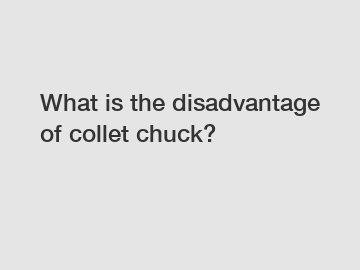What is the disadvantage of collet chuck?
Collet chucks are a popular tool holding option in machining and turning applications due to their ability to securely hold workpieces in place. However, like any tool, collet chucks also come with their own set of disadvantages that users should be aware of. In this article, we will explore some of the drawbacks of using collet chucks in manufacturing processes.
Limited Clamping Range.
One of the main disadvantages of collet chucks is their limited clamping range. Collet chucks are designed to hold specific-sized workpieces, and changing the size of the workpiece often requires replacing the collet. This can be time-consuming and inefficient, especially in environments where multiple workpiece sizes are used regularly. Additionally, the need for multiple collets to accommodate different workpiece sizes can result in increased tooling costs.

Lack of Precision.
While collet chucks are generally known for their precision and accuracy, they can be prone to inaccuracies when clamping workpieces with irregular shapes or non-concentric profiles. In certain applications, such as precision machining or high-speed turning, even small deviations in clamping accuracy can result in dimensional inaccuracies and surface finish issues. This limitation may require users to use alternative workholding solutions for parts that require high precision.
Limited Grip Strength.
Another drawback of collet chucks is their limited grip strength compared to other workholding options, such as jaw chucks or magnetic chucks. While collets are capable of holding workpieces securely for most applications, they may not be suitable for heavy-duty machining or roughing operations where high cutting forces are involved. In such cases, users may experience issues such as tool chatter, tool deflection, or workpiece slippage, which can compromise the quality of the final product.
Complex Setup.
Collet chucks require precise setup and adjustment to ensure proper clamping force and concentricity. This setup process may be cumbersome for inexperienced users or operators who are not familiar with the nuances of collet chuck operation. Improper setup can lead to issues such as workpiece deformation, tool breakage, or reduced tool life. Additionally, the need for specific collets for different workpiece sizes adds to the complexity of tool changes and setup procedures.
Limited Accessibility.
In some cases, the design of collet chucks may limit the accessibility of the workpiece, especially in confined or hard-to-reach areas. This can make it challenging for operators to change tools, inspect workpieces, or perform maintenance tasks efficiently. Limited accessibility can also pose safety risks, as operators may need to reach into tight spaces to manipulate the collet chuck, increasing the likelihood of accidents or injuries.
Conclusion.
While collet chucks offer numerous benefits in terms of precision, accuracy, and workpiece security, they also have certain disadvantages that users should consider. From limited clamping range and lack of precision to limited grip strength and complex setup procedures, collet chucks may not be suitable for every machining or turning application. By understanding these drawbacks, users can make informed decisions about the best workholding solutions for their specific needs.
Contact Us.
If you have any questions or concerns about collet chucks or other workholding options, please do not hesitate to contact us. Our team of experts is here to help you find the right solution for your machining needs.
For more Er Sealed Collet, Hydraulic Tools Definition, Spindle Runout Test Barinformation, please contact us. We will provide professional answers.

Comments
0